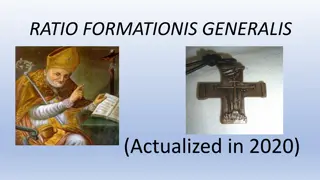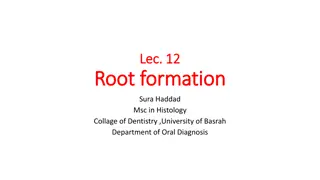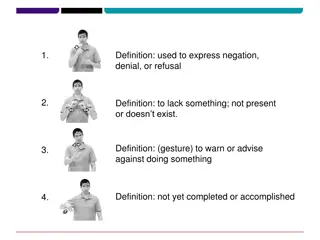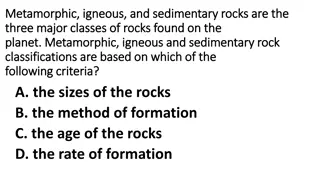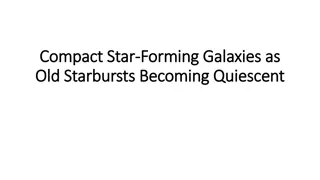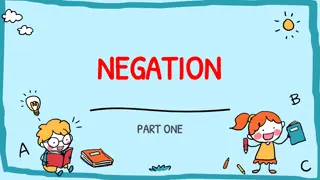English Negation Formation & Realization
This lecture delves into English negation rules, covering formation methods with auxiliary verbs or "do," types of negation like clausal and non-clausal, and affixal negation using negative prefixes. Explore various ways to express negation in English.
Download Presentation

Please find below an Image/Link to download the presentation.
The content on the website is provided AS IS for your information and personal use only. It may not be sold, licensed, or shared on other websites without obtaining consent from the author.If you encounter any issues during the download, it is possible that the publisher has removed the file from their server.
You are allowed to download the files provided on this website for personal or commercial use, subject to the condition that they are used lawfully. All files are the property of their respective owners.
The content on the website is provided AS IS for your information and personal use only. It may not be sold, licensed, or shared on other websites without obtaining consent from the author.
E N D
Presentation Transcript
ENGLISH NEGATION FORMATION 1. The negative particle (not) is inserted after the auxiliary verb: Edward can swim= Edward cannot swim. We must go there= We must not go there. He had gone home = He had not gone home. 2. If there is more than one auxiliary verb, the negative particle (not) is inserted after the first auxiliary verb: It has been raining = It has not been raining We have been playing football = We have not been playing football.
3. If there is no auxiliary verb, the verb (do) is used: He drives the car = He does not drive the car. Alex ate rice = Alex did not eat rice. He likes music = He does not like music. I have a car = I do not have a car.
ENGLISH NEGATION REALIZATION Negation in English is typically realized in one of three ways: 1. Negating the verbal element by using (NOT): He is not late. She cannot swim. I am not late. John does not have a car.
2. Using such negative forms as: (never), (nobody), (no), (nothing), (none): He is never on time. Nobody was here. No one is allowed. I have nothing to say. I thought she was famous, but none of my friends have ever heard of her.
3. Using semi negative forms: (hardly), (rarely) , (barely), (scarcely), (seldom), (little), (few): He hardly agrees with me. Tom is rarely late. He had barely enough money to pay for the car. The city had scarcely changed in 20 years. I seldom arrive late. There is little milk left. There are few cars on the road after midnight.
Types of Negation There are three types of negation: 1-Clausal Negation: the whole clause is negated. I have not seen her. I saw nobody / no one. 2-Non-Clausal / (Local) Negation: only one constituent is negated. They live not far from here. I visit them not frequently.
3-Affixal Negation: negating an item by adding one of the negative prefixes to it: un- / a- / dis- / in- / non- / im- / ir / il :
This is untrue. He is dissatisfied with his job. He is such an amoral, selfish person. The analysis remains incomplete. Both countries agreed on non-interference in each other's internal affairs. This task seems impossible. She was taken to hospital suffering from an irregular heartbeat. The team was penalized for an illegal play.
SCOPE OF NEGATION The scope of the negation refers to the effect of negative items on the part of the clause that follows them. Some: is outside of the scope of negation in: She did not type some of the reports. The sentence can be paraphrased as: Some reports were typed, others were not.
Any: is inside the scope of negation in: She did not type any of the reports. The sentence means: None of the reports were typed. No: is used when the scope of the negation is more focused and emphatic: She typed no reports. I had no money. (The sentence is more emphatically negative) I did not have any money.
ARABIC NEGATION Arabic has the following negative particles: / / / / And the negative verb Their uses are governed by the tense of the verb that they negate. They precede the verb or noun which they negate.
: can be used to negate a verb in a verbal sentence or a noun in a verbless sentence: / : used to negate the verb in the imperfect jussive form:
can be used to negate a verb in a verbal sentence or a noun in a verbless sentence: : *
is used to negate imperfect verbs in subjunctive mood and expresses an emphatic future negation:
This defective verb is one of the sisters of the verb kaana It typically negates a nominal sentence, but it can also be used in verbal sentences with imperfect indicative verbs: It can also be used in negative questions:
CONTRAST The following differences hold between English and Arabic negation: 1. Arabic has negative particles each of which co occurs with a particular verb tense, whereas English (not) is not governed by the tense of the verb which it negates.
2. English has clausal, local and affixal negation, whereas Arabic mainly has clausal negation. 3. English has post auxiliary negation, while Arabic has preverbal negation.








